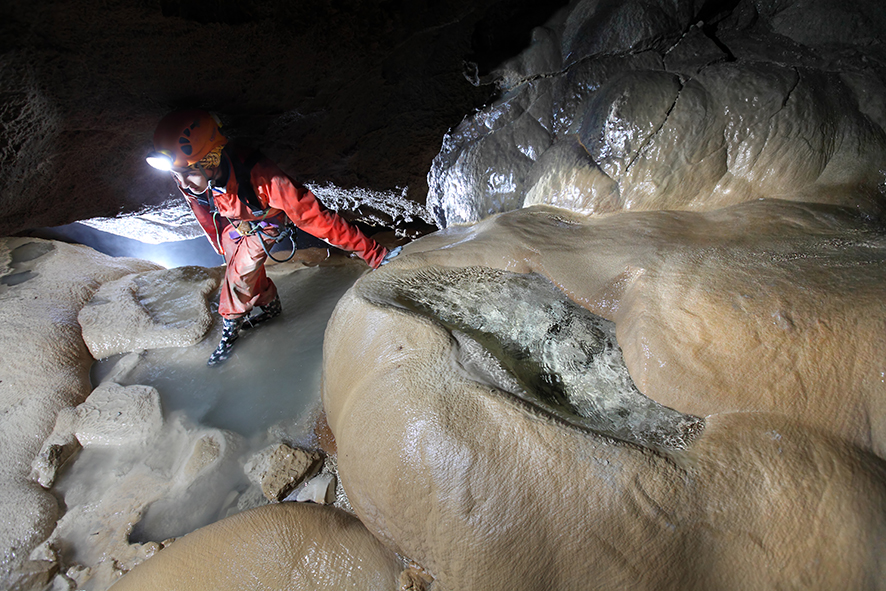Karst hydrogeology

The hydrogeological behaviour of soluble rocks such as carbonates, evaporites and quartz-arenites is strictly related to the geomorphology of these karst areas. The typical external morphology, characterised by dolines, sinkholes and caves is the result of the hydrogeological evolution of these aquifers through time.
The response of the springs to infiltration events can be very different, but is always characterised by a more or less rapid increase in flow rate and important geochemical variations. These aquifers are also very vulnerable to pollution, and their sustainable management is fundamental to guarantee the protection of these important groundwater resources. Even though these aquifers are already widely used in the world (around ¼ of the Earth’s population drinks karstic water) there are still ample possibilities to increase their domestic use.
The study of these aquifers is often multidisciplinar, and comprises physical-chemical and microbiological analysis of the waters, isotope geochemistry, dye tracing with artificial and natural tracers, and the construction of hydrodynamical models. These methods are based on a sound knowledge of the geological and structural conditions of the karstified rocks and on the presence of caves and underground rivers. These studies normally involve cavers and local speleological organisations.
In these last years the studies have regarded the hydrogeology of the evaporite karst areas (Piedmont and Emilia-Romagna), general hydrogeological investigations in prealpine areas and mountain karsts (Cansiglio, Alburni, Sardinia), and pollution events in Sicily.
Several Natura 2000 sites have been investigated in the framework of a European project “Life + Gypsum”, both from geochemical and microbiological standpoint. This investigation allowed identifying anthropic and natural polluted sites.
In the Philippines, in the Puerto Princesa Underground River Park, chemical analyses and continuous monitoring of the waters have been carried out to understand the hydrogeological behaviour of the river in different hydrodynamical conditions (flood and drought), also in relation with the tides.
In Venezuela, in the quartz-arenitic mountains (Tepui), chemical analyses of the waters have been performed to understand the importance of dissolutional processes in the formation of caves in these tropical regions.
In the last period the researches have also focussed on the movement of water in the vadose zone of karst aquifers, using a combination of hydrochemical and isotopic monitoring and the construction of flow models.
Selected Publications (2014-2020)
Mecchia Marco, Sauro Francesco, Piccini Leonardo, De Waele Jo, Sanna Laura, Tisato Nicola, Lira Jesus, Vergara Freddy (2014) - Geochemistry of surface and subsurface waters in quartz-sandstones: significance for the geomorphic evolution of tepui table mountains (Gran Sabana, Venezuela). Journal of Hydrology 511, pp. 117-138 (DOI: 10.1016/j.jhydrol.2014.01.029). (IF2014 3.053, Scopus 19, Google Scholar 21)
Gutiérrez Francisco, Parise Mario, De Waele Jo, Jourde Hervé (2014) - A review on natural and human-induced hazards and impacts in karst. Earth-Science Reviews 138, pp. 61-88 (DOI: 10.1016/j.earscirev.2014.08.002). (IF2014 7.885, Scopus 284, Google Scholar 382)
Ruggieri Rosario, Forti Paolo, Antoci Maria Lucia, De Waele Jo (2017) - Accidental contamination during hydrocarbon exploitation and the rapid transfer of heavy-mineral fines through an overlying highly karstified aquifer (Paradiso Spring, SE Sicily). Journal of Hydrology, 546, pp. 123-132 (DOI: 10.1016/j.jhydrol.2016.12.046). (IF2017 3.727, Scopus 4, Google Scholar 5)
D’Angeli Ilenia Maria, Serrazanetti Diana I., Montanari Chiara, Vannini Lucia, Gardini Fausto, De Waele Jo (2017) - Geochemistry and microbial diversity of cave waters in the gypsum karst aquifers of Emilia Romagna region, Italy. Science of the Total Environment, 598, pp. 538-552. (DOI: 10.1016/j.scitotenv.2017.03.270). (IF2017 4.610, Scopus 10, Google Scholar 11)
Vigna Bartolomeo, D’Angeli Ilenia Maria, Fiorucci Adriano, De Waele Jo (2017) - Hydrogeological flow in gypsum areas: some examples from northern Italy and main circulation models. International Journal of Speleology, 46(2), pp. 205-217. (DOI: 10.5038/1827-806X.46.2.2095). (IF2017 1.392, Scopus 9, Google Scholar 10)
Filippini Maria, Squarzoni Gabriella, De Waele Jo, Fiorucci Adriano, Vigna Bartolomeo, Grillo Barbara, Riva Alberto, Rossetti Stefano, Zini Luca, Casagrande Giacomo, Stumpp Christine, Gargini Alessandro (2018) - Differentiated spring behavior under changing hydrological conditions in an Alpine karst aquifer. Journal of Hydrology, 556, pp. 572-584. (DOI: 10.1016/j.jhydrol.2017.11.040). (Scopus 16, Google Scholar 22)
Mecchia Marco, Sauro Francesco, Piccini Leonardo, Columbu Andrea, De Waele Jo (2019) - A hybrid model to evaluate subsurface chemical weathering and fracture karstification in quartz sandstone. Journal of Hydrology, 572, pp. 745-760. (DOI: 10.1016/j.jhydrol.2019.02.026). (Scopus 3, Google Scholar 4)
Sanna Francesco, Sanna Laura, De Waele Jo, Vigna Bartolomeo (2019) - Sustainable karst groundwater management in a semiarid region: the case of Su Gologone spring (Sardinia, Italy). Rendiconti Online della Società Geologica Italiana, 47, p. 102-207 (DOI: 10.3301/ROL.2019.19). (Scopus 0, Google Scholar 0)
Antonellini Marco, Nannoni Alessia, Vigna Bartolomeo, De Waele Jo (2019) - Structural control on karst water circulation and speleogenesis in a lithological contact zone: the Bossea cave system (Western Alps, Italy). Geomorphology, 345, Article 106832, 21 pages (DOI: /10.1016/j.geomorph.2019.07.019). (Scopus 4, Google Scholar 3).